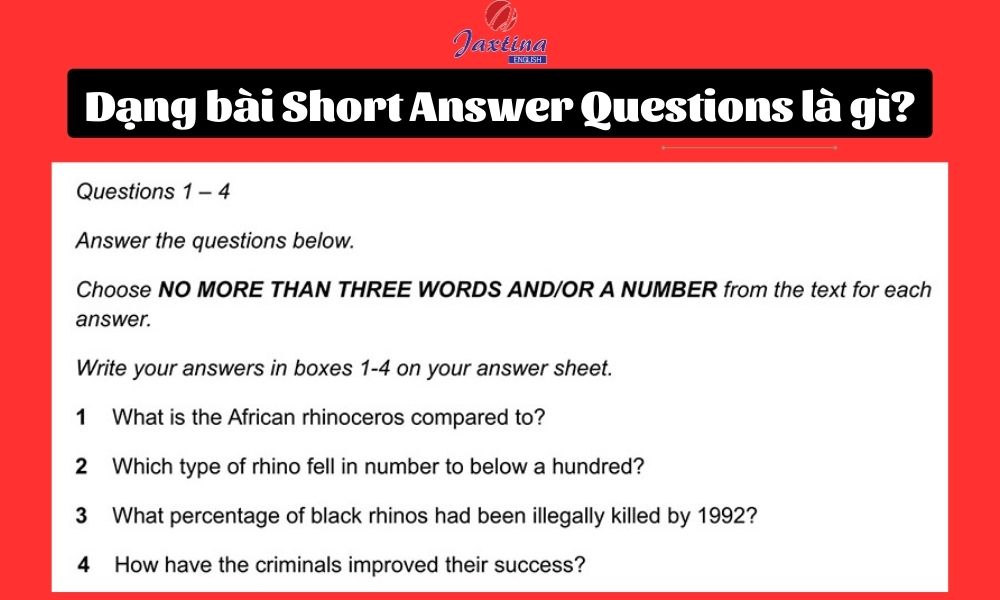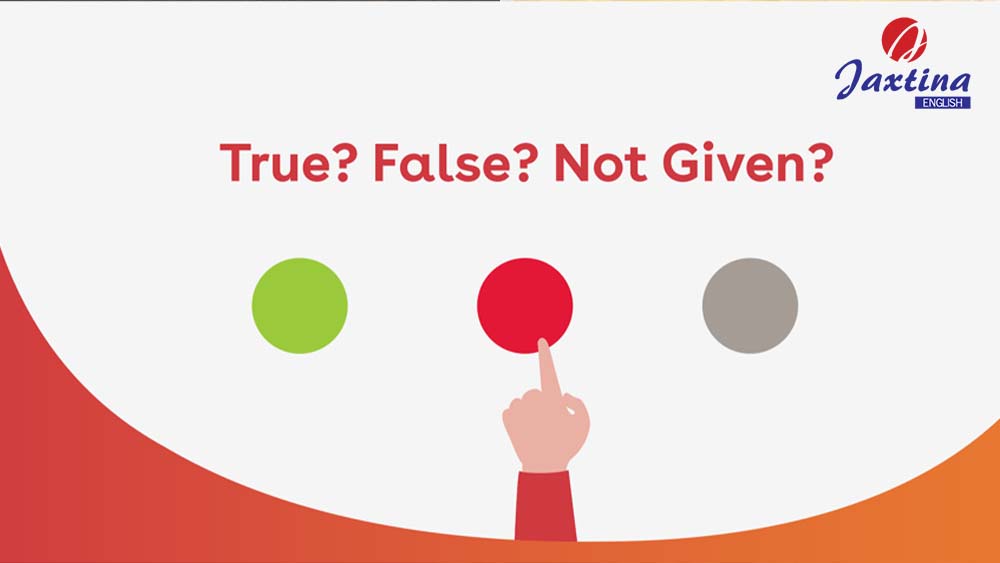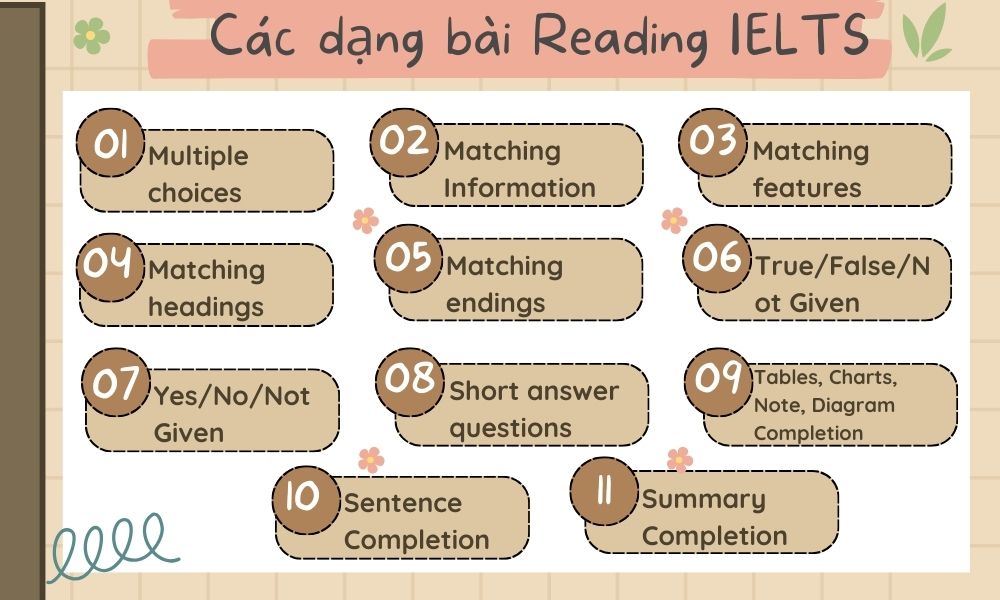Modified multiple choice (MCQ) là gì? Cách làm Multiple choice
4 bước làm dạng bài Short Answer Questions IELTS Reading
Hẳn bạn sẽ nhận ra dạng bài short answer question là một dạng bài khá quen thuộc dẫu cho tần suất xuất hiện là không nhiều khi luyện thi IELTS. Tuy nhiên, dạng bài trên cũng ẩn chứa những kiểu “bẫy” khó nhằm đánh lừa các bạn. Bài viết dưới đây, Jaxtina sẽ giới thiệu tổng quan về loại này cũng như chiến lược làm hiệu quả.
Đọc thêm: Luyện đề IELTS cùng 99 bộ đề thi mới nhất có đáp án
Nội dung bài viết
1. Dạng bài Short Answer Questions là gì? Format dạng bài trong IELTS Reading
Short Answer Questions là một dạng bài trả lời câu hỏi ngắn trong phần thi IELTS Reading. Đối với dạng này, thí sinh cần phải trả lời bằng các từ hoặc cụm từ. Đồng thời, đáp án của dạng bài này sẽ bị giới hạn ở một số từ. Về cơ bản, bạn có thể hình dung dạng bài này như điền từ vào chỗ trống.
Dưới đây sẽ là format dạng bài trong IELTS Reading:

Format dạng bài Short Answer Question
>>>> Tìm Hiểu Chi Tiết: Cách luyện Reading IELTS hiệu quả mà bạn không nên bỏ qua
2. Chiến lược 4 bước làm dạng bài Short Answer Questions
Dạng bài Short Answer không quá khó nhưng để dành được điểm cao nhất đòi hỏi bạn phải biết chiến thuật làm bài. Dưới đây, Jaxtina sẽ hướng dẫn 4 bước làm dạng bài này:

Chiến lược 4 bước làm dạng bài Short Answer Questions
2.1 Bước 1: Đọc kĩ đề bài
Bước đầu tiên và vô cùng quan trọng khi làm dạng bài Short Answer là đọc kĩ đề bạn. Bạn cần xem kỹ để nắm giới hạn từ hoặc số điền vào chỗ trống.
Chẳng hạn như đề bài ghi ONE WORLD ONLY, bạn có thể hiểu là chỉ điền một từ vào chỗ trống một từ. Hoặc đề ghi là From the passage, bạn hiểu rằng chỉ có thể sử dụng các từ được lấy từ bài đọc. Bạn tuyệt đối không được phép thay đổi từ vựng, paraphrase, …
2.2 Bước 2: Đọc câu hỏi kỹ càng, gạch chân từ khóa chính
Sau khi đã đọc kỹ đề bài, bạn sẽ đọc kỹ phần câu hỏi cùng gạch chân từ khóa và dự đoán được thông tin mà mình đang kiếm.
Đối với keyword sẽ thường được chia là hai dạng là Changeable keywords và Unchangeable Keywords:
- Changeable keywords: Đây là các từ khóa có tính biến đổi trong bài. Đồng thời, những từ này có khả năng bị paraphrase hoặc các từ như danh từ, tính từ, động từ.
- Unchangeable keywords: Các từ khóa không thể bị thay đổi, chẳng hạn như tên riêng, ngày tháng, tên khoa học, …
2.3 Bước 3: Skimming (đọc lướt) đoạn văn
Bạn hãy tiến hành đọc lướt bài để có thể nắm toàn bộ thông tin của đoạn văn. Bạn có thể chú ý vào câu đầu tiên để nắm được câu chủ đề (topic sentence).
2.4 Bước 4: Tìm đoạn có chứa đáp án & đánh dấu
Sau khi đọc lướt, bạn có thể tìm được đoạn chứa đáp án, bạn hãy đánh dấu vào đề. Lưu ý bạn chỉ được đánh dấu vào đề bài khi làm tại nhà. Khi đi thi thực tế không được viết vào đề thi.
2.5 Bước 5: Kiểm tra lại đáp án
Sau khi đã đọc và tìm được đáp án cho câu hỏi, bạn hãy áp dụng lần lượt với các câu hỏi khác. Cuối cùng hãy kiểm tra lại đáp án và tiến hành nộp bài.
>>>> Bạn có thể tìm hiểu thêm về một dạng bài IELTS Reading phổ biến khác là Summary Completion tại bài viết Cách làm dạng bài Summary Completion
3. TIPs làm bài Short Answer Questions hiệu quả tránh sai sót
Để làm dạng bài Short Answer Questions hiệu quả hơn, bạn có thể tham khảo ngay các tips làm bài sau:
3.1 Các lỗi thường dễ mắc phải
Đối với dạng bài IELTS Reading này, việc bạn cần làm là tìm ra thông tin và loại từ cần thiết cho câu hỏi và trả lời nó dưới dạng ngắn gọn nhất có thể theo yêu cầu của đề bài (chính là word limit). Nghe qua thì có vẻ khá đơn giản phải không nào? Nhưng thực ra thí sinh hay mắc phải các lỗi sau:
- Đôi khi có nhiều bạn dựa vào phán đoán, hiểu biết cá nhân của mình để chọn đáp án mà quên mất rằng toàn bộ đáp án hay thông tin đều nằm trong bài viết.
- Một vài bạn khi làm bài sẽ gặp khó khăn để nhận biết từ được paraphrase. Nhiều bạn còn có xu hướng tìm kiếm từ khóa trong bài đọc y hệt như trọng câu hỏi. Tuy nhiên, ở một vài trường hợp, từ khóa có thể được biến đổi thành các từ đồng nghĩa.
- Không chú ý đến số lượng từ giới hạn trong phần trả lời. Phần này thường được ký hiệu trong đề Word limit. Nếu bạn viết vượt quá số từ, bạn sẽ không được tính điểm.
- Nhiều bạn cố gắng đọc hiểu hết toàn bộ câu chữ trọng bài. Đây là điều không nên bởi sẽ mất khá nhiều thời gian. Bạn hãy áp dụng kỹ năng đọc lướt để xác định được câu trả lời.

Các tips làm dạng bài Short Answer
3.2 Cách tránh “bẫy” khi làm dạng bài Short Answer Question
Một số cách tránh bẫy khi làm dạng bài Short Answer như:
1. Hãy tập trung vào keywords (hoặc từ đồng nghĩa) trong câu hỏi vì nó sẽ xuất hiện lại trong đoạn văn.
2. Câu trả lời thường xuất hiện theo trật tự của bài đọc. Ví dụ khi tìm thấy keyword câu hỏi nằm ở đoạn 4 thì bạn nên tập trung vào nó, tránh mất thời gian đọc lại bài đọc.
3. Trong đề bài sẽ luôn có hướng dẫn cụ thể về Word limit cho các câu trả lời. Bạn nên lưu ý và kiểm tra lại cẩn thận để tránh bị mất điểm.
4. Đáp án CHỈ được chọn dựa trên thông tin trong bài đọc, vì vậy đừng nên dựa vào kiến thức cá nhân để suy đoán.
5. Luôn luôn kiểm tra lại đáp án sau khi điền. Chỉ cần một chút lỗi nho nhỏ về chính tả hay ngữ pháp cũng sẽ làm bạn mất điểm.
Về cơ bản thì Short answer questions không phải là một dạng bài khó nhưng nó đòi hỏi bạn phải cẩn thận cũng như nhanh nhạy trong việc tìm ra thông tin chính xác cần điền. Vì vậy mà, Jaxtina hy vọng những lưu ý trên sẽ giúp bạn có thêm kỹ năng giúp cho việc giải quyết dạng bài này trở nên thuần thục hơn
Xem Thêm: Kỹ năng skimming và scanning
4. Bài tập
Còn bây giờ thì, hãy áp dụng các tips trên vào bài tập dưới đây nhé!
Practice 1. Read the passage and do the following task below (Đọc bài viết và làm theo yêu cầu dưới đây):
THE 2003 HEATWAVE
It was the summer, scientists now realise, when global warming at last made itself unmistakably felt. We knew that summer 2003 was remarkable: Britain experienced its record high temperature and continental Europe saw forest fires raging out of control, great rivers drying to a trickle and thousands of heat-related deaths. But just how remarkable is only now becoming clear.
The three months of June, July and August were the warmest ever recorded in western and central Europe, with record national highs in Portugal, Germany and Switzerland as well as in Britain. And they were the warmest by a very long way. Over a great rectangular block of the earth stretching from west of Paris to northern Italy, taking in Switzerland and southern Germany, the average temperature for the summer months was 3.78°C above the long-term norm, said the Climatic Research Unit (CRU) of the University of East Anglia in Norwich, which is one of the world’s leading institutions for the monitoring and analysis of temperature records.
That excess might not seem a lot until you are aware of the context – but then you realise it is enormous. There is nothing like this in previous data, anywhere. It is considered so exceptional that Professor Phil Jones, the CRU’s director, is prepared to say openly – in a way few scientists have done before – that the 2003 extreme may be directly attributed, not to natural climate variability, but to global warming caused by human actions.
Meteorologists have hitherto contented themselves with the formula that recent high temperatures are “consistent with predictions” of climate change. For the great block of the map – that stretching between 35-50N and 0-20E – the CRU has reliable temperature records dating back to 1781. Using as a baseline the average summer temperature recorded between 1961 and 1990, departures from the temperature norm, or “anomalies”, over the area as a whole can easily be plotted. As the graph shows, such is the variability of our climate that over the past 200 years, there have been at least half a dozen anomalies, in terms of excess temperature – the peaks on the graph denoting very hot years – approaching, or even exceeding, 2°C. But there has been nothing remotely like 2003, when the anomaly is nearly four degrees.
“This is quite remarkable,’ Professor Jones told The Independent. “It’s very unusual in a statistical sense. If this series had a normal statistical distribution, you wouldn’t get this number. The return period [how often it could be expected to recur] would be something like one in a thousand years. If we look at an excess above the average of nearly four degrees, then perhaps nearly three degrees of that is natural variability, because we’ve seen that in past summers. But the final degree of it is likely to be due to global warming, caused by human actions.”
The summer of 2003 has, in a sense, been one that climate scientists have long been expecting. Until now, the warming has been manifesting itself mainly in winters that have been less cold than in summers that have been much hotter. Last week, the United Nations predicted that winters were warming so quickly that winter sports would die out in Europe’s lower-level ski resorts. But sooner or later, the unprecedented hot summer was bound to come, and this year it did.
One of the most dramatic features of the summer was the hot nights, especially in the first half of August. In Paris, the temperature never dropped below 23°C (73.4°F) at all between 7 and 14 August, and the city recorded its warmest-ever night on 11-12 August, when the mercury did not drop below 25.5°C (77.9°F). Germany recorded its warmest-ever night at Weinbiet in the Rhine Valley with a lowest figure of 27.6°C (80.6°F) on 13 August, and similar record-breaking nighttime temperatures were recorded in Switzerland and Italy.
The 15,000 excess deaths in France during August, compared with previous years, have been related to the high night-time temperatures. The number gradually increased during the first 12 days of the month, peaking at about 2,000 per day on the night of 12-13 August, then fell off dramatically after 14 August when the minimum temperatures fell by about 5°C. The elderly were most affected, with a 70 per cent increase in mortality rate in those aged 75-94.
For Britain, the year as a whole is likely to be the warmest ever recorded, but despite the high temperature record on 10 August, the summer itself – defined as the June, July and August period – still comes behind 1976 and 1995, when there were longer periods of intense heat. “At the moment, the year is on course to be the third hottest ever in the global temperature record, which goes back to 1856, behind 1998 and 2002, but when all the records for October, November and December are collated, it might move into second place/’ Professor Jones said. The ten hottest years in the record have all now occurred since 1990. Professor Jones is in no doubt about the astonishing nature of the European summer of 2003. “The temperatures recorded were out of all proportion to the previous record,” he said.
“It was the warmest summer in the past 500 years and probably way beyond that. It was enormously exceptional.”
His colleagues at the University of East Anglia’s Tyndall Centre for Climate Change Research are now planning a special study of it. “It was a summer that has not been experienced before, either in terms of the temperature extremes that were reached, or the range and diversity of the impacts of the extreme heat,” said the centre’s executive director, Professor Mike Hulme.
“It will certainly have left its mark on a number of countries, as to how they think and plan for climate change in the future, much as the 2000 floods have revolutionised the way the Government is thinking about flooding in the UK. The 2003 heatwave will have similar repercussions across Europe.”
Questions 20-21
Answer the questions below using NO MORE THAN TWO WORDS AND/OR NUMBERS from the passage for each answer.
What are the other two hottest years in Britain besides 2003?
- _______________________
What has also influenced government policies like the hot summer in 2003?
- _______________________
Xem đáp án
|
Bài viết trên đây Jaxtina đã giới thiệu đến bạn đọc dạng bài Short Answer Question. Mong rằng với những chia sẻ vừa rồi đã giúp bạn hiểu rõ hơn về dạng bài này cũng như cách làm hiệu quả. Chúc bạn sẽ ôn luyện hiệu quả và đạt kết quả cao trong kỳ thi IELTS nhé. Hãy tiếp tục áp dụng nó vào những bài tập tiếp theo sau này nhé! Và nếu bạn vẫn còn bối rối không biết nên làm như thế nào, đừng ngại ngần gì mà đến với trung tâm Tiếng Anh Jaxtina. Jaxtina tự hào tiên phong trong cách học đổi mới sáng tạo, giúp bạn tiếp thu kiến thức tốt hơn và hiệu quả hơn với giáo trình nước ngoài được cập nhật và phương pháp dạy học tiên tiến, bao gồm việc giúp bạn ôn luyện hiệu quả các dạng bài trong IELTS Reading.
Jaxtina chúc bạn học tập tốt!
Nguồn bài đọc tham khảo từ: Reading Passage 2 – IELTS Recent Actual Test
Đừng Bỏ Qua:

Đơn giản hoá việc học tiếng Anh

Tiên phong đào tạo
tiếng Anh toàn diện 4 kỹ năng.









